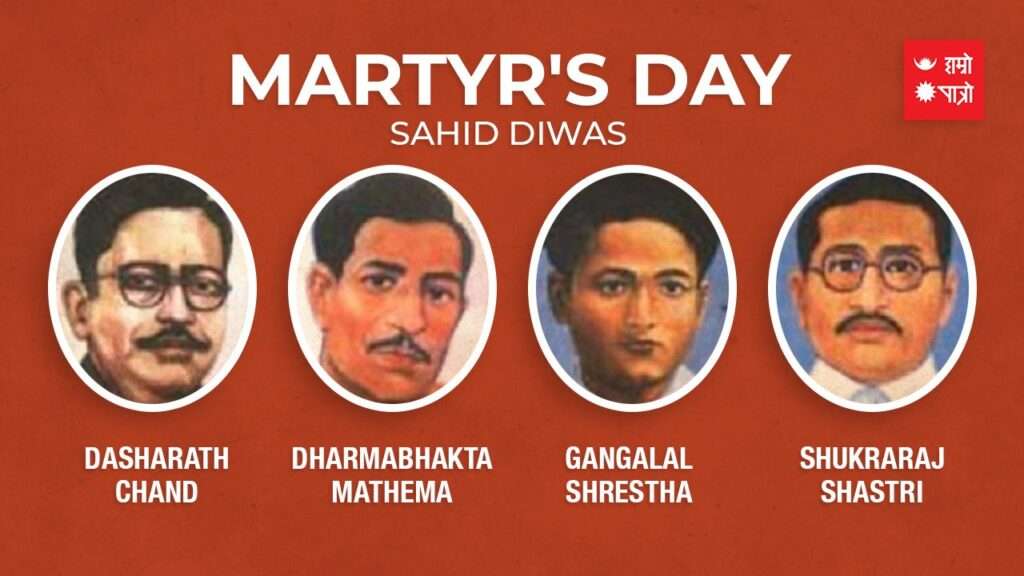Martyr Changed the Course of History
Dr. Nawa Raj Subba
(Dr. Nawa Raj Subba’s article highlights the role of the Martyrs-of-Nepal. According to the essay, Martyrs have altered the course of the country’s history. The information comes from his newly released book, ‘Both Sides of Coins.’)
We have not easily gotten the freedom, civil rights, and rights that we have today. People all over the world have fought against autocracy to get rid of various kinds of shackles and to establish human rights. As a result, many people have been martyred in various campaigns for rights. A martyr dedicates himself to the welfare of the people without any selfishness. Only brave men fight for the natural, social and cultural upliftment of the country.
In Nepal, many martyrs gave their lives in opposition to the family rule. As a result, the family Rana rule was abolished. Political changes occurred in Nepal as a result of the influence of freedom and human rights movements from outside the country. People have become citizens as a result of the movement. As a result, remembering the known and unknown martyrs, as well as expressing gratitude to history, should not be overlooked.
In our country, the first Rana Prime Minister, Jung Bahadur Rana, has accused Lakhan Thapa Magar of campaigning against him. Thus, Jung Bahadur martyred Lakhan Thapa Magar by hanging in a forest tree near Manakamana Temple on Phalgun 20, 1933 VS. Lakhan Thapa Magar had rebelled against Rana on the pretext of independence. He sacrificed his life against the pro-British policies and autocracy of the Rana regime. This was the first sacrifice against the Rana regime.
History and the present days show that the Shah and Rana consider Nepal as their ancestral property. The Rana regime ruled the people cruelly as governing subjects. They always kept the country in darkness. For a long time, the country and the people were deprived of basic services such as education and health. As a result, there was a wave against the Rana rule in the country. In 1997 VS, the autocratic Rana government martyred Shukraraj Shastri, Dharmabhakta Mathema, Dashrath Chand, and Gangalal Shrestha by hanging and shooting them from a tree at Teku Pachali in Kathmandu. Four brave sons sacrificed their lives in the Nepali democratic movement. They became immortal martyrs in the democratic movement for the rights and welfare of the people.
The Rana prime ministers had also captured Shah kings. The Rana Prime Minister used to rule in the king’s name by influencing the Shah King. King Tribhuvan sought refuge at the Indian Embassy to escape Rana’s rule. It was the Indian Embassy that brought him to New Delhi. King Tribhuvan, the Rana family, and the democratic powers all signed a treaty in Delhi. As a result, although Rana became the Prime Minister, the power of the king captured by Rana was returned. King Tribhuvan was restored to the throne. In this way, democracy was declared in Nepal in 2007 VS. Today, we celebrate this political development as Democracy Day.
However, since then, some scholars, including historian Shastra Dutta Pant, say that India began to interfere in Nepal after that political turn.
After 2007, King Tribhuvan became the Father of the Nation of Nepal. The government declared four martyrs of the recent past. The government built Martyr’s Gate in Tundikhel, Kathmandu, where the statues of King Tribhuvan and four martyrs were placed. Ironically, Lakhan Thapa Magar, the first martyr who fought against Rana during Jung Bahadur’s time, was not recognized by the then government out of prejudice.
In history, power plays with martyrs. Although it has been formally announced that the Rana rule has ended in the country, the Ranas dominated the system of governance in Nepal and still do so. Therefore, the government of Nepal did not immediately honour Lakhan Thapa Magar, the first martyr who fought against him, after 2007. Even after the Rana rule ended, it happened due to their influence. Due to public desire and pressure, Lakhan Thapa Magar was declared the first martyr of Nepal only in 2056 VS.
Lakhan Thapa Magar was a prominent opponent of the Rana government. Who stressed the political awareness and sentiments of indigenous people. He objected to Jung Bahadur’s false takeover of power. When Jung Bahadur came to power, he could not tolerate the fact that he sold the country by unnecessarily colluding with British rule. The Rana regime promoted social discrimination by placing the tribes in the lower castes through the Country Act of 1854. Lakhan Thapa Magar did not like the state’s promoting untouchability and discrimination in the community. He moved against the state for bringing unjust rules and regulations and depriving the people of the opportunity of an education. As a result, Lakhan Thapa Magar took bold steps against the Rana regime’s injustice and atrocities.
Lakhan Thapa Magar organized people in the Manakamana fort to overthrow Jung Bahadur. He declared movement against the government by lighting a lamp of consciousness and taking out a procession on the streets in 1932 VS. Jung Bahadur came out to extinguish the fire of public awareness and rebellion. The Rana regime crushed the people’s voices, and Lakhan Thapa Magar was defeated. He was martyred in 1933 VS. A brave son with a dream to change the face of the country became immortal in history by sacrificing his life when he took action against the Rana regime for the first time.
The autocratic Rana regime of the Shah era increased social discrimination. The Rana regime adopted a policy of suppressing the indigenous people’s language, script, and culture. For example, the then government controlled the language and writing of the indigenous Kirat Limbu living in eastern Nepal. There was a fear among Shah kings and Rana rulers that they would revolt against the state through ethnic unity through language and script. Gorkha state expanded during the unification of Nepal. The then Gorkhali ruler In 1845 VS, Teangsi Sing (Sen) Thebe, who was teaching Kirat Limbu language in Chainpur Sankhuwasabha, tried to capture the Thebe, and he escaped from there. Thebe was expelled by the then Gorkhali ruler on charges of propagating the Kirat Limbu language, script, and culture.
Thebe fled to Sikkim to save his life. However, he continued teaching the Kirat Limbu language and script there. Buddhists ruled Sikkim at that time. They did not tolerate the existence and identity of other languages, scripts, and cultures. As a result, promoting the Kirat Limbu language and writing was thought to affect the Buddhist tradition. The presence of Teangsi Sing (Sen) Thebe became unbearable to the Lamas there. One day, the Lamas captured Thebe and killed him inhumanly. In this way, Teangsi Sing (Sen) Thebe sacrificed his life while working for the Limbu language and script. He became a brave martyr of the Kirat language, writing, and culture.
There has been a lot of change in Nepal today. However, the Government of Nepal does not seem to know him. According to the Constitution of Nepal 2072 VS, the mother tongue spoken in Nepal has become the Nepali nation’s language. Ironically, mainstream Nepali Khas language literature does not see any justification for inquiring about Thebe, the martyr of the Kirat Limbu national language, who grew up on the soil of Nepal.
After the unification of Nepal or the expansion of Gorkha, the defeated indigenous Kirat Limbu language and culture did not get a chance to grow and grow in its native land. The regime controlled the practice of native language and script in Nepal, Sikkim, and Darjeeling, Limbu-dominated areas. Because there was also a Rana-friendly British policy. At the people’s level, sometimes, if he was found to have used the language and script inside, he was chased, captured, or killed by spying. The rulers of that time used to do heinous things like destroying language, script, and culture. This writer had heard about such developments from the mouths of many elders. Some things have also come out in writing.
It was difficult to save one’s life due to fear of power. For this reason, the story of giving up its traditional language and script due to compulsion has become a sad history. As a result, today, Kirat Limbu language and literature are in a state of decay. According to history and elders, books and manuscripts of Kirat Limbu language literature were confiscated by the then ruler and burnt to a large extent. If the history of human culture, language, and literature are explored, if the indigenous mind is touched, then black spots of tyrannical rulers are found in it.
It is the sacrifice of the martyrs that changed the political structure and structure of Nepal. With the advent of a democratic federal republic in Nepal, the indigenous people’s language, script, and culture have got an opportunity to flourish. Today, the minds of the indigenous people have started coming out in the open. They have been able to express their grievances to the nation of Nepal.
Different ethnicities have become aware of the preservation and development of other mother tongues and scripts. It is customary to teach the mother tongue at the rural municipality level. Now the local governments prepare the curriculum and textbooks in local languages. Mother’s tongue has started to be taught in schools. Now the indigenous people have started dreaming of opening colleges and universities. Of course, this should be considered a favourable situation. This current situation is due to martyrdom.
Women also became the victim of power in Nepali society. Under the guise of scriptures, the state had legally placed women as the second citizen. Interest groups, power, and politics had a big hand in such an unjust arrangement. Such horrors victimized women as child marriage, polygamy, and the Sati system during the Lichchavi, Malla, and Rana periods. As a result, women in society started to resemble objects and animals. In this way, culture long suppressed the cry for women’s freedom and identity.
In eastern Nepal, women rebelled against injustice, atrocities, social evils, and evils against women. Under the leadership of Bhojpur-born Yogmaya Neupane, women sacrificed their lives for liberation from community and state oppression. In 1998 VS, 67 women, including Yogmaya, collectively took drawn Jal samadhi in the Koshi River. They sacrificed their lives against atrocities against women.
A courageous social campaign by women in the eastern hill districts led to a revolution against Rana. As a result, the social movement against the conservative society took a violent turn. The emotional force generated by that life-long struggle of women gave a solid boost to the transformation of society. The sacrificial message of women created social unity against injustice, resulting in the collapse of the Rana regime. The sacrifice of martyrs against superstitions, evils, and evil practices prevailing in society brought a political wave.
Martyrs have been born in Nepal in the political and social sectors and environmental protection. Profiteers are trying to destroy the environment by exploiting the natural resources of Nepal’s forests and rivers. The number of such gangs is increasing day by day. We have found a brave Nepali son who sacrificed his life while fighting against anti-environment groups.
Dilip (Om Prakash) Mahato of Mithila Municipality-5 made a concerted effort to stop the exploitation of natural resources in the Chure area of Nepal. Dilip Mahato was murdered in 2076 VS by a profit-making group involved in exploiting river-based resources. When he tried to stop at the exploitation site, he was crushed to death by a dozer. Mahato sacrificed his precious life in the campaign to protect the environment and control the exploitation of Chure. In this way, Dilip (Om Prakash) Mahato has become the first martyr of Nepal’s environmental protection campaign.
The government has not yet included Dilip Mahato on the list of martyrs. Because special interests control governments, history will highly respect his contribution. Time will evaluate it. Let us look optimistically at life and the world. At all times, the power and selfish elements drink the blood of most martyrs at no cost. History keeps an account of the martyrs who have disappeared. One day the time will come because the time is substantial.
Today is Martyrs’ Day. Let us get to know these brave sons, who rarely appear in the political and social spheres. Let us remember their contribution on the morning of Martyrs’ Day. Let’s bow our heads to their assistance. May the dreams of the known and unknown martyrs come true. The martyrs will always live.
References
Ale Magar, Jivan (2022) Nepalka Pratham Sahid: Lakhan Thapa Magar, Sahid Lakhan Thala Gaupalika, Gaupalikako Karyalaya, Gorkha Jilla, Nepal. https://shahidlakhanmun.gov.np/
Birgunj Sanjaal (2076, Magh 3) Dilipko Hatyaralai Hadai Sammako Karavahi Garaune Mukhyamantri Tautko Bhanai, Birgunj Sanjaal TV. https://birgunjsanjal.com/2020/01/12120/
Budhathoki, Tarabahadur (2075, Bhadra 2) Yogmaya Ek Krantikari Virangana, Purbeli News, , https://purbelinews.com/246988
Chemjong, Imansing (2003) Kirat Itihas, Lalitpur, Kirat Yakthung Chumlung.
Pant, Shastradutta (2021) Vishal Nepal Pharkincha, Bharatle Nepalsanga Yuddha Lade Harcha, MCC pass Hudaina, YouTube [Video] https://youtu.be/DII_HLkx9hQ


